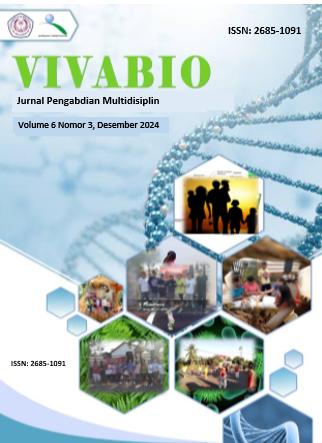Aplikasi Bioetanol Aren Sebagai Disinfektan Untuk Peternakan Ayam
(Application of Palm Bioethanol as a Disinfectant for Chicken Farming)
DOI:
https://doi.org/10.35799/vivabio.v6i3.57858Keywords:
Bioetanol; Arenga Pinnata; Disinfektan; Peternakan Unggas; AntimikrobaAbstract
This work explores the application of bioethanol derived from the sap of Arenga pinnata (sugar palm) as a disinfectant in poultry farming. Bioethanol, commonly known as an alternative fuel, also has strong antimicrobial properties, making it effective in eliminating bacteria, viruses, and fungi. Using Arenga pinnata as a bioethanol source provides a sustainable solution by leveraging renewable resources and reducing reliance on more hazardous chemical disinfectants. The study covers bioethanol production through fermentation, optimizing fermentation conditions to maximize ethanol yield. The antimicrobial efficacy tests show that bioethanol significantly reduces microbial load on poultry farm equipment and surfaces. Furthermore, feeding sick poultry with bioethanol-enhanced feed led to noticeable improvements within 2-3 days. These findings highlight bioethanol’s potential as an eco-friendly and safe disinfectant for both workers and poultry, offering practical guidelines for its application in farming.
ABSTRAK
Kegiatan ini membahas penggunaan bioetanol yang dihasilkan dari nira pohon aren (Arenga pinnata) sebagai disinfektan untuk peternakan ayam. Bioetanol, yang biasanya dikenal sebagai bahan bakar alternatif, juga memiliki kemampuan antimikroba yang kuat, sehingga efektif dalam membunuh bakteri, virus, dan jamur. Penggunaan pohon aren sebagai bahan baku bioetanol menawarkan solusi berkelanjutan dengan memanfaatkan sumber daya terbarukan dan mengurangi ketergantungan pada disinfektan kimia yang lebih berbahaya. Studi ini melibatkan produksi bioetanol melalui proses fermentasi dan optimalisasi kondisi fermentasi untuk memaksimalkan produksi etanol. Hasil pengujian menunjukkan bahwa bioetanol ini efektif dalam mengurangi jumlah mikroba pada peralatan dan permukaan di peternakan. Penggunaan bioetanol dalam pakan unggas yang sakit juga menghasilkan peningkatan kesehatan yang signifikan dalam 2-3 hari. Hasil ini menunjukkan potensi besar bioetanol sebagai disinfektan ramah lingkungan yang aman bagi pekerja dan unggas, sekaligus memberikan panduan penerapan praktis di peternakan..
References
Ansar, Nazaruddin, Azis, A. D., & Fudholi, A. (2021). Enhancement of bioethanol production from palm sap (Arenga pinnata (Wurmb) Merr) through optimization of Saccharomyces cerevisiae as an inoculum. Journal of Materials Research and Technology, 14, 548-554. DOI: 10.1016/j.jmrt.2021.06.085.
Aui, A., & Wang, Y. (2023). Cellulosic ethanol production: Assessment of the impacts of learning and plant capacity. Technological Forecasting and Social Change, 197, 122923. DOI: 10.1016/j.techfore.2023.122923.
Boyce, J. M., & Pittet, D. (2002). Guideline for Hand Hygiene in Health-Care Settings. Morbidity and Mortality Weekly Report (MMWR), 51(RR16), 1-44. DOI: 10.1016/S0196-6553(02)70015-9.
Chylkova, T., Cadena, M., Ferreiro, A., & Pitesky, M. (2017). Susceptibility of Salmonella biofilm and planktonic bacteria to common disinfectant agents used in poultry processing. Journal of Food Protection, 80(7), 1072-1079. DOI: 10.4315/0362-028X.JFP-16-393.
Clausen, P. A., Frederiksen, M., Sejbæk, C. S., Sørli, J. B., Hougaard, K. S., Frydendall, K. B., ... & Wolkoff, P. (2020). Chemicals inhaled from spray cleaning and disinfection products and their respiratory effects: A comprehensive review. International Journal of Hygiene and Environmental Health, 229, 113592. DOI: 10.1016/j.ijheh.2020.113592.
Haryoso, A., Zuhud, E.A.M., Hikmat, A., Sunkar, A., & Darusman, D. (2020). Ethnobotany of sugar palm (Arenga pinnata) in the Sasak Community, Kekait Village, West Nusa Tenggara, Indonesia. Biodiversitas, 21(1), 117-128. DOI: 10.13057/biodiv/d210116.
Itiki, R., & Roy Chowdhury, P. (2020). Fast deployment of COVID-19 disinfectant from common ethanol of gas stations in Brazil. Health Policy and Technology, 9(3), 384-390. DOI: 10.1016/j.hlpt.2020.08.007.
Li, F., Huo, J., Zhuang, Y., Xiao, H., Wang, W., & Huang, L. (2020). Anti-nociceptive and anti-inflammatory effects of the ethanol extract of Arenga pinnata (Wurmb) Merr. fruit. Journal of Ethnopharmacology, 248, 112349. DOI: 10.1016/j.jep.2019.112349.
Maier, A., Ovesen, J. L., Allen, C. L., York, R. G., Gadagbui, B. K., Kirman, C. R., ... & Quiñones-Rivera, A. (2015). Safety assessment for ethanol-based topical antiseptic use by health care workers: Evaluation of developmental toxicity potential. Regulatory Toxicology and Pharmacology, 73(1), 248-264. DOI: 10.1016/j.yrtph.2015.06.019.
McDonnell, G., & Russell, A. D. (1999). Antiseptics and disinfectants: activity, action, and resistance. Clinical Microbiology Reviews, 12(1), 147-179. DOI: 10.1128/CMR.12.1.147.
Mogea, J., Seibert, B., & Smits, W. (1991). Multipurpose palms: The sugar palm (Arenga pinnata (Wurmb) Merr.). Agroforestry Systems, 13(2), 111-129. DOI: 10.1007/BF00140236.
Nainggolan, N., & Pandiangan, D. (2019). Pemberdayaan Kaum Bapa Masyarakat Pesisir Amurang Lopana Satu Untuk Mengembangkan Wisata Pantai dengan Pendekatan Holistik. VIVABIO: Jurnal Pengabdian Multidisiplin, 1(2), 27–35. https://doi.org/10.35799/vivabio.1.2.2019.24979
Nainggolan, N., Pandiangan, D., Adinata, H. S., & Mutu, P. (2024). PKM Pasang Panel Surya Oven Biovina Untuk Perbaikan Bahan Baku : Penurunan Kadar Air dan Kontaminasi Kapang. 6, 152–159.
Sangian, H. F., & Tongkukut, S. (2011). Study of Bio-Ethanol Preparation from Arenga Palm Sugar. Jurnal Ilmiah Sains, 11(2), 260-267.
Song, M., Hossain, M. I., Jung, S., Yeo, D., Wang, Z., Min, A., ... & Choi, C. (2022). Comparison of virucidal efficacy of sodium hypochlorite, chlorine dioxide, peracetic acid, and ethanol against hepatitis A virus by carrier and suspension tests. International Journal of Food Microbiology, 363, 109506. DOI: 10.1016/j.ijfoodmicro.2021.109506.
Ulum, M. B., & Saputra, D. H. R. (2020). Otomatis spray desinfektan kandang ayam dengan Android berbasis Arduino Uno. International Journal on Human Computing Studies, 2(2), 28-32.
Wlaźlak, S., Pietrzak, E., Biesek, J., & Dunislawska, A. (2023). Modulation of the immune system of chickens: A key factor in maintaining poultry production—a review. Poultry Science, 102(8), 102785. DOI: 10.1016/j.psj.2023.102785.
Wulandari, S., Erikania, S., & Maritha, V. (2021). Anti-bacterial activity test of ethanol extracts and ethyl acetate fraction from the extract of Jatropha curcas L. leaves against Staphylococcus aureus. Journal of Vocational Health Studies, 5(1), 31-38. DOI: 10.20473/jvhs.V5.I1.2021.31-38.
DOI: 10.1016/j.jep.2019.112349
Downloads
Published
How to Cite
Issue
Section
License
Copyright (c) 2024 Authors

This work is licensed under a Creative Commons Attribution-ShareAlike 4.0 International License.



